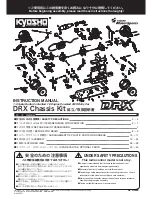
Page
Hi-Speed Adjustment
After initial acceleration, the engine should pull at a steady rate while maintaining a two-stroke whine and a noticeable
trail of smoke. If the engine labors and is sluggish with heavy smoke, the mixture is too rich and needs to be leaned
by turning the high-speed needle clockwise in one-hour increments until it runs smoothly. If the engine isn't smoking or
starts to die after acceleration, it is too lean and you must richen the mixture by turning the needle counterclockwise. Don't
be confused by the sound of the engine and the actual performance. A leaner mixture will produce an exhaust note with a
higher pitch but this does not necessarily mean improved performance, as the engine is on the verge of overheating and
may incur possible damage. Ideally you want to run the engine so that it is on the slightly rich side of optimum.
This will give you the best combination of speed and engine life.
CAUTION:
The engine is too lean and overheating if it
accelerates rapidly with a high-pitched scream then seems to labor, stops smoking, or loses speed. This can be caused by the
terrain, atmospheric conditions, or drastic altitude changes. To avoid permanent engine damage,
immediately
richen the
mixture by turning the high-speed needle counterclockwise at least "two hours" and be prepared for further adjustments
before running any more.
About Glow Plugs
The glow plug is like the ignition system in your automobile. The coiled element in the
center of the plug glows red hot when connected to a 1.5-volt battery (located in the igniter).
This is what ignites the fuel/air mixture when compressed in the cylinder. After the engine fires,
the heat generated by the burning fuel keeps the element hot. Common reasons for the engine
not starting are the 1.5-volt battery being weak or dead, the glow plug being wet with fuel, or the
element burned out. Use a spare glow plug to check the igniter. If the igniter makes the element
glow, remove the plug from the engine to check it in the same manner. A wet glow plug means there is excess fuel in
the engine. To eliminate this, put a rag over the head and turn the engine over a few seconds with your "Spin-Start."
Reinstall the glow plug, making sure you have the brass gasket on it. The engine should now start.
Testing the Temperature
The ideal operating temperature for the engine will vary with the air temperature but in general it should be in the
200°F to 230°F (93.3°C to 110°C) range. A simple way to check the engine temperature is to put a few drops of water
on the top of the head/heat sink. It should take 3−5 seconds for the water to evaporate. If it boils away quickly the
engine is overheating and the high-speed needle needs to be richened (turned counterclockwise) at least "two hours."
If you plan on racing or prolonged high-speed running, there are several inexpensive handheld digital temperature
gauges available, like the LOSA99171, you may want to invest in.
About the Radio
The JR radio installed in the Mega Baja is a professional level system with more than the
usual features you may find useful. Be sure to read through the included radio manual
for complete instructions. The following is a simple guide refers to items that are
commonly used and/or needed to run your model.
1. Power Switch - Turns your transmitter ON and OFF
2. Steering Wheel - Controls the steering of your model
3. Steering Trim Tab - Allows you to fine-tune the neutral
position of the steering
4. Throttle Trigger - Pull back for throttle and push forward for brakes
5. Throttle Trim Tab - Allows you to set the idle/brake of the model
6. Transmitter Dislay - Digital readout shows battery voltage, frequency,
feature functions/settings
7. Transmitter Antenna - Transmits signal to the receiver in the model
1
2
3
4
5
6
7
DYN2500 Shown
Содержание Losi Mega Baja
Страница 18: ...Page 18 B2256 B2256...
Страница 19: ...Page 19...
Страница 20: ...Page 20 FRONT ASSEMBLY...
Страница 21: ...Page 21 B2451 REAR ASSEMBLY...






































